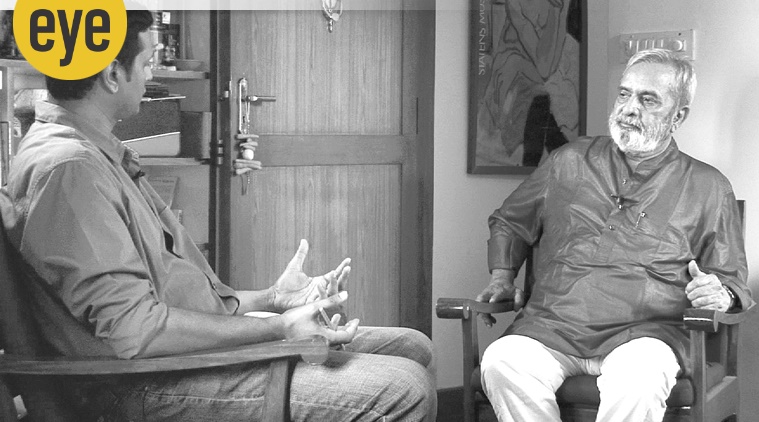 Think Tank: UR Ananthamurthy (right) with Chandan Gowda
Think Tank: UR Ananthamurthy (right) with Chandan Gowda
Renowned Kannada writer UR Ananthamurthy (1932-2014) is best known to us as the author of Samskara (1965) and as a public intellectual. URA restlessly reflected on the problems of this world and had an urge to share these reflections with friends and visitors. He, therefore, immensely enjoyed conversing with others as much as thinking and writing about our life. The present book, A Life in the World: UR Ananthamurthy in Conversation with Chandan Gowda, is the result of one such conversation.
These conversations were shot at URA’s residence by Chandan Gowda, an eminent translator of URA’s fiction, along with a team of members from Azim Premji University, Bengaluru. This book, a by-product of such a documentary exercise, is structured into 10 chapters. These chapters not only reveal the mind of one of modern India’s great writers but also his penetrating insights into the varied issues of 20th century India. The first three chapters ‘Early Years’, ‘Mysore’ and ‘Birmingham and After’ reconstruct the intellectual formation of URA. From a Brahmin agrahara through Maharaja’s College in Mysore to Birmingham University, his experiences with this world contributed to his “world making”. He did not completely reject one space for another, but critically imbibed the virtues of all. Therefore, he became a critical insider, as the famous description of him goes.
The Mysore milieu produces in URA a voracious reader beyond the syllabus, and there, in the company of a poet like Gopal Krishna Adiga, he discovers himself as a navya writer. However, a completely new world opens up for him as he arrives in Birmingham to pursue his PhD. In England, his association with great cultural critics like Raymond Williams, Richard Hoggart, EP Thompson, David Lodge and the like does not influence him to become yet another Indian cultural critic, but his English days help him rediscover Kannada deeply and imbibe the art of writing a novel.
The remaining seven chapters are conversations that cover the cultural and political problems of India. Particularly, the chapters ‘Tradition’, ‘Language’, ‘A Few Friends’ and ‘Karnataka’ offer deep insights into literature, language, Kannada writers, the Veerashaiva movement, pen portraits of Kannada writers, intellectuals and politicians, among others. It is in one such conversation that URA makes a distinction between traditionalism and tradition. He says, “How to preserve the past is the concern of the traditionalists. My concern is not how to preserve the past, but how to make the past useful for the present world.”
In the chapter ‘Being in Public’, we come across the idea of a common school which he believes is necessary for bringing about social changes in India. The chapter ‘Language’ continues his public concern, particularly his views on translation, language in general, and the interface between Kannada and English. For URA, translation is an everyday practice in multilingual spaces like India as we often switch over from one set of codes and registers to another.
In yet another chapter ‘Karnataka’, URA contemplates on the making of modern Karnataka and the Kannada tradition. The chapter ‘India’s Political Life’ adds another dimension to the conversation as URA examines Mahatma Gandhi, BR Ambedkar, Jawaharlal Nehru and Ram Manohar Lohia. In his view, Gandhi, who played with ideas, was suspicious of the modern world system because we can hurt any part of the world by doing something wrong in any other part of the world. URA looks at Gandhi and Ambedkar as complementary minds. “Both Gandhi and he (Ambedkar),” URA says, “take different spiritual journeys. One takes a spiritual journey and says ‘Hey Ram’ and dies, and Ambedkar takes to Buddhism and dies. Gandhi uses Ram for politics and Ambedkar uses Buddha for politics…”
In the final chapter ‘In Conclusion’, we get to know about URA’s personal tastes, including his favourite cuisine, favourite writers, attachments, his dislike for middle-class backbiting, among other things. As a finale, he states that he wishes to be remembered as a teacher and a writer — a Kannada writer.
Gowda’s questions, as much straightforward as possible, do not interfere much in the course of the conversation. However, for a writer like URA, deeply probing questions like the craft of his fiction — how he constructed plots and fashioned his Kannada for his fictional narratives; how he wrestled with his writing — and such other questions of techne would have made this volume richer.
Gowda’s introduction, which gives an overview of URA’s works and thought, could have expanded on how such conversations extend the boundaries of autobiography. However, after reading URA’s autobiography Suragi (2012), it is a different experience to listen to this speaking autobiography.
NS Gundur is the chairman, department of English Studies, Davangere University, Karnataka
A Life in the World: UR Ananthamurthy in Conversation with Chandan Gowda (courtesy: harper collins)
Harper Collins
204 pages
`399